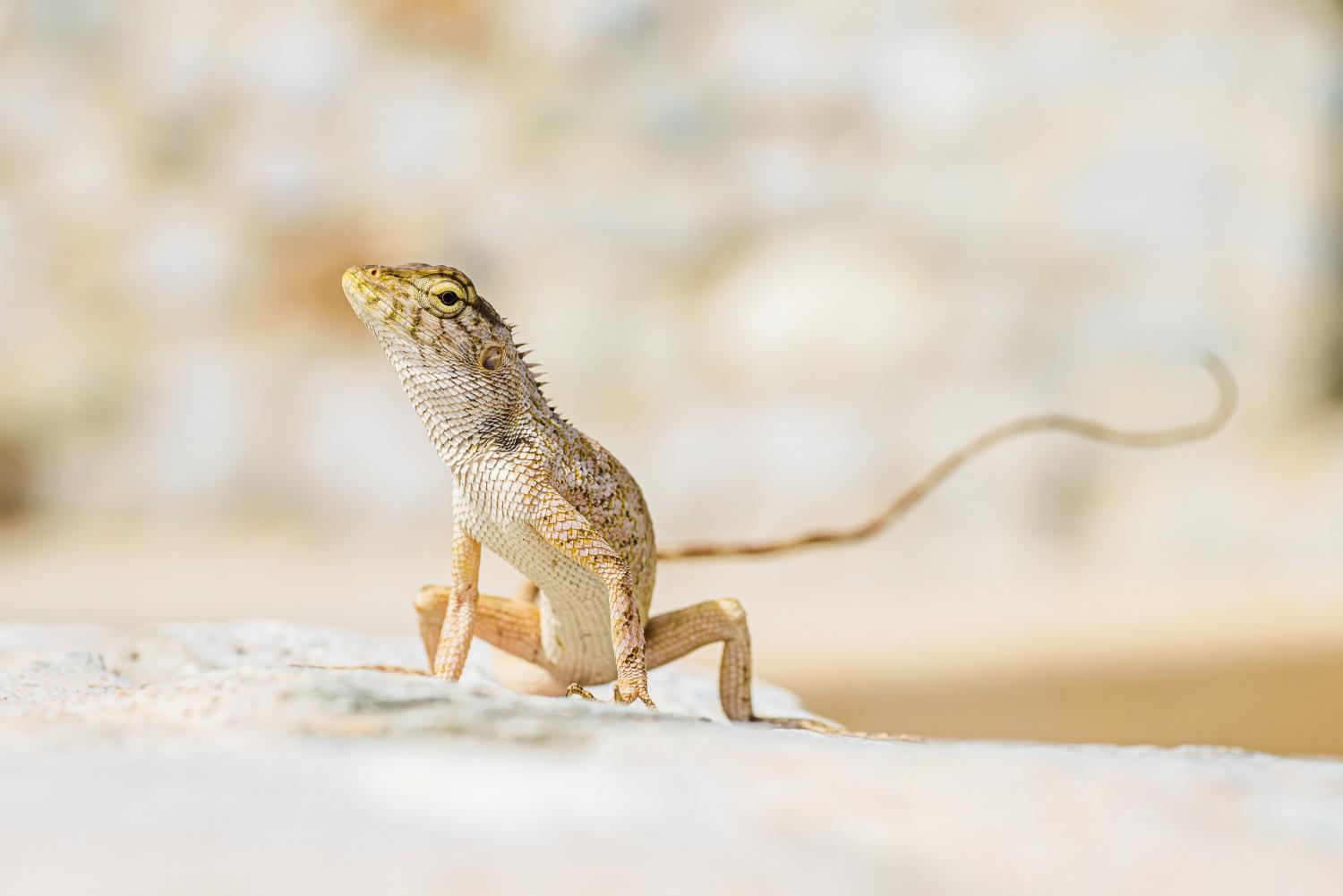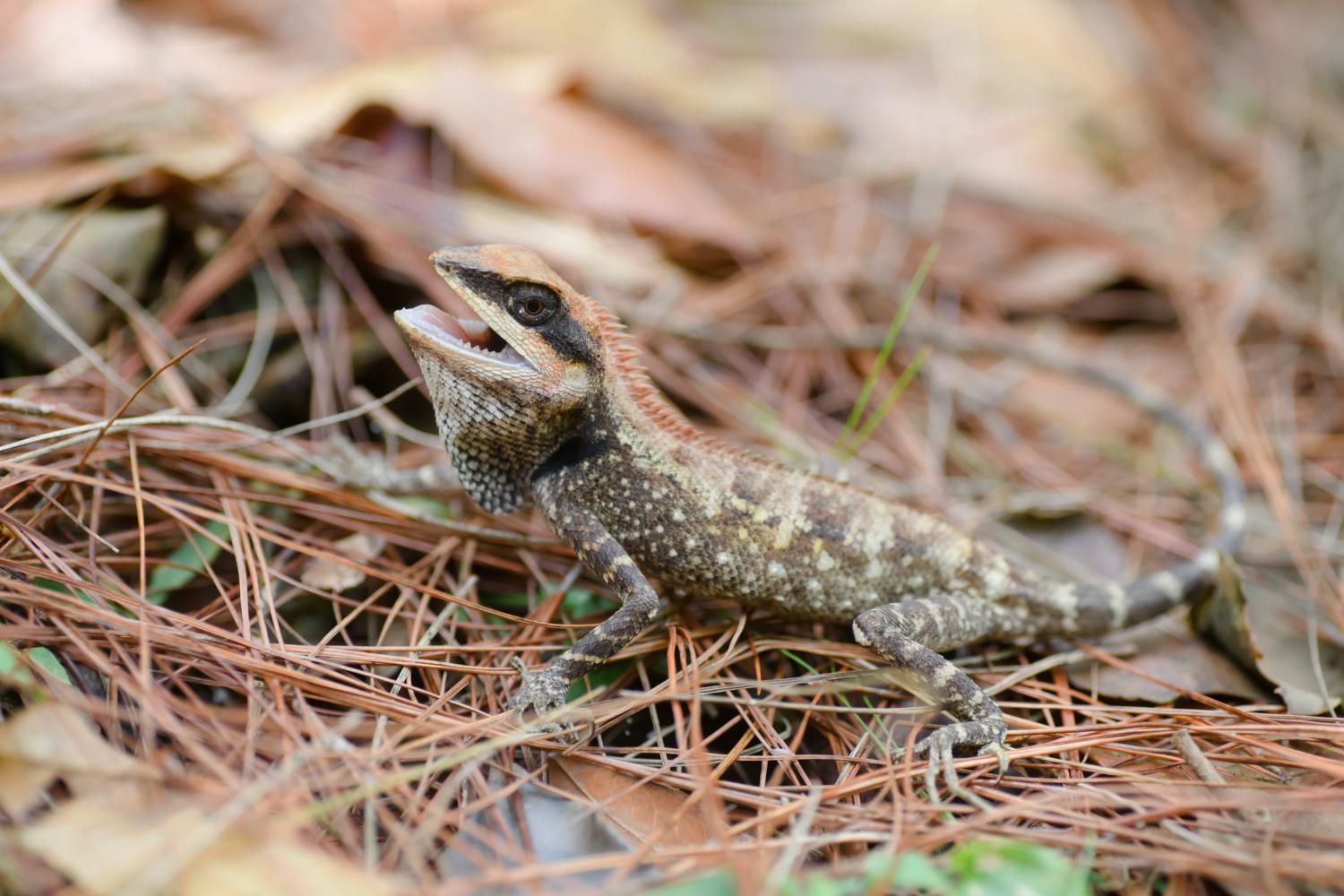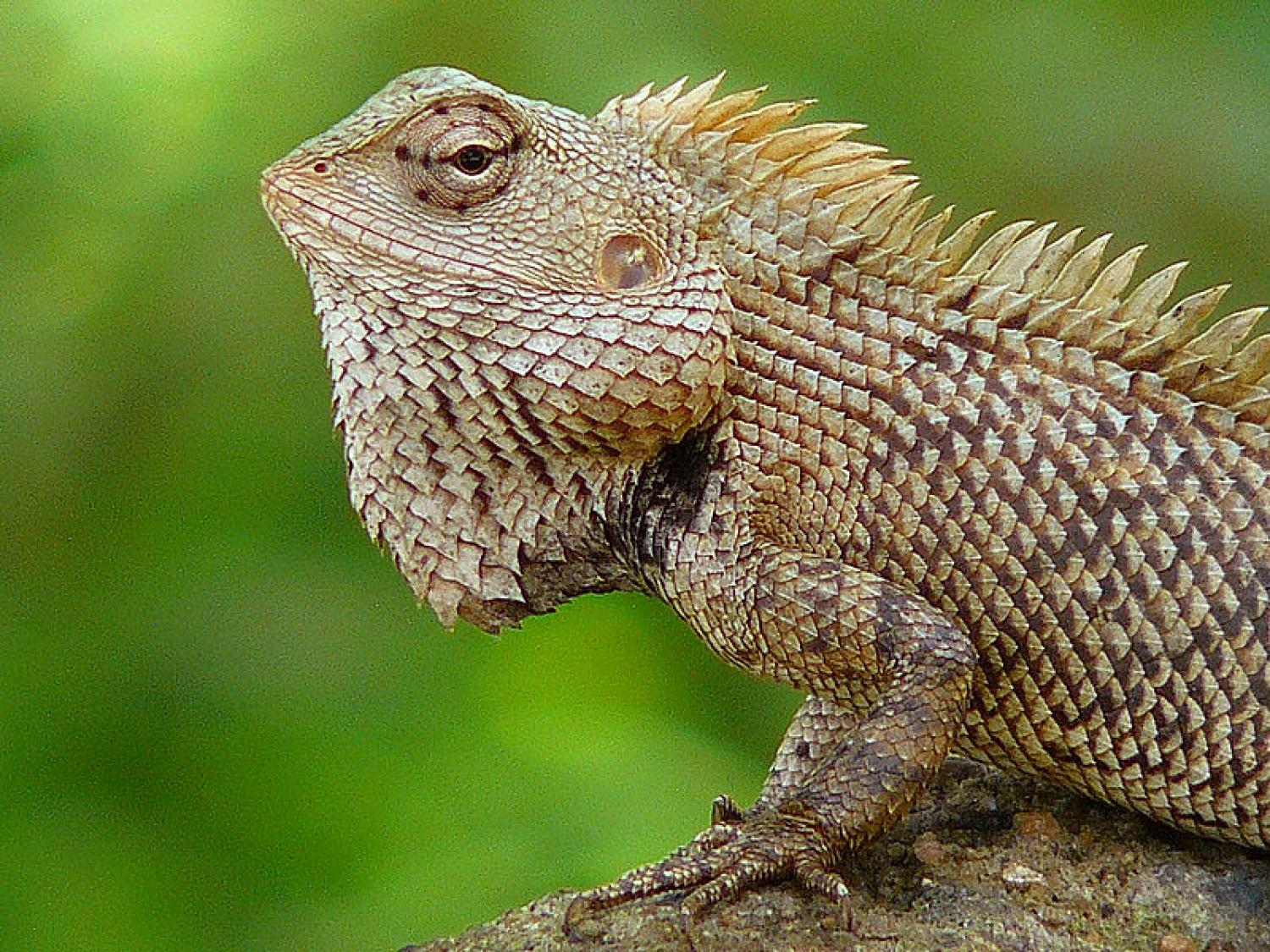Species of Thailand
Garden crested lizard
Calotes versicolor
François Marie Daudin, 1802
In Thai: กิ้งก่าคอแดง
The oriental garden lizard, eastern garden lizard, bloodsucker or changeable lizard (Calotes versicolor) is an agamid lizard found widely distributed in indo-Malaya. It has also been introduced in many other parts of the world.
Description
It is an insectivore and the male gets a bright red throat in the breeding season.
It measures over 10 cm (3.9 in) in length snout-to-vent. Total length including the tail is up to 37 cm (14.5 in).
Two small groups of spines, perfectly separated from each other, above each tympanum. Dorsal crest moderately elevated on the neck and anterior part of the trunk, extending on to the root of the tail in large individuals, and gradually disappearing on the middle of the trunk in younger ones. No fold in front of the shoulder, but the scales behind the lower jaw are much smaller than the others; gular sac not developed. From thirty-nine to forty-three series of scales round the middle of the trunk. The hind foot (measured from the heel to the extremity of the fourth toe) is not much longer than the head in the adult, whilst it is considerably longer in the young. The coloration is very variable, sometimes uniform brownish or greyish-olive or yellowish. Generally broad brown bands across the back, interrupted by a yellowish lateral band. Black streaks radiate from the eye, and some of them are continued over the throat, running obliquely backwards, belly frequently with greyish longitudinal stripes, one along the median line being the most distinct; young and half-grown specimens have a dark, black-edged band across the inter-orbital region.
The ground-colour is generally a light brownish olive, but the lizard can change it to bright red, to black, and to a mixture of both. This change is sometimes confined to the head, at other times diffused over the whole body and tail. A common state in which it may be seen (as stated by Mr. Jerdon) is, seated on a hedge or bush, with the tail and limbs black, head and neck yellow picked out with red, and the rest of the body red. Jerdon and Blyth agree that these bright, changeable colours are peculiar to the male during the breeding-season, which falls in the months of May and June.
Mouhot has collected in Siam one of those fine variations of colours, which, however, appear to be infinite. It has the usual cross streaks between the eyes and the radiating lines continent of India to China; it is very common in Ceylon, not extending into the temperate zone of the Himalayas. Ceylonese specimens are generally somewhat larger; one of them measured 16 inches, the tail taking 11 inches. It is found in hedges and trees; it is known in Ceylon under the name of "Bloodsucker", a designation the origin of which cannot be satisfactorily traced; in the opinion of Kelaart, the name was given to it from the occasional reddish hue of the throat and neck. The female lays from five to sixteen soft oval eggs, about 5/8 of an inch long, in hollows of trees, or in holes in the soil which they have burrowed, afterward covering them up. The young appear in about eight or nine weeks. In a hot sunny day a solitary Bloodsucker may be seen on a twig or on a wall, basking in the sun, with mouth wide open. After a shower of rain numbers of them are seen to come down on the ground and pick up the larva and small insects which fall from the trees during the showers.
During the breeding season, the male's head and shoulders turns bright orange to crimson and his throat black. Males also turn red-headed after a successful battle with rivals. Both males and females have a crest from the head to nearly the tail, hence their other common name "Crested Tree Lizard".
Changeable Lizards are related to iguanas (which are found only in the New World). Unlike other lizards, they do not drop their tails (autotomy), and their tails can be very long, stiff and pointy. Like other reptiles, they shed their skins. Like chameleons, Changeable Lizards can move each of their eyes in different directions.
Distribution
The native range of the species includes SE Iran, Afghanistan, Bangladesh, Bhutan, Cambodia, China (South) (Yunnan, Guangdong, Guangxi, Hong Kong, Hainan Island), India (including the Andaman Islands), Indonesia (Sumatra), Malaysia (Western), Maldives, Mauritius (Reunion, Rodrigues), Myanmar, Nepal, Pakistan, Philippines, Sri Lanka (Ceylon), Thailand, Vietnam (including Pulo Condore Island). It has been introduced to Brunei, Celebes, Oman, Seychelles, Singapore and United States. The lizards were introduced to Singapore from Malaysia and Thailand in the 1980s. In Singapore, they are a threat to the native Green-Crested Lizard.
The Changeable Lizard is relatively common and found in a wide range of habitats. They appear to adapt well to humans and are thus not endangered. They are commonly found among the undergrowth in open habitats including highly urban areas.
Diet
Changeable Lizards eat mainly insects such as crickets, grasshoppers, ants and small vertebrates, including rodents and other lizards. Although they have teeth, these are designed for gripping prey and not tearing it up. So prey is swallowed whole, after it is stunned by shaking it about. Sometimes, young inexperienced Changeable Lizards may choke on prey which are too large. Occasionally changeable lizards also consume vegetable matter.
Reproduction
Males become highly territorial during breeding season. They discourage intruding males by brightening their red heads and doing "push-ups". Each tries to attract a female by inflating his throat and drawing attention to his handsomely colored head. Oviparous; about 10—20 eggs are laid, buried in moist soil. The eggs are long, spindle-shaped and covered with a leathery skin. They hatch in about 6–7 weeks. They are able to breed at about 1 year old.
This article uses material from Wikipedia released under the Creative Commons Attribution-Share-Alike Licence 3.0. Eventual photos shown in this page may or may not be from Wikipedia, please see the license details for photos in photo by-lines.
Scientific classification
- Kingdom
- Animalia
- Phylum
- Chordata
- Class
- Reptilia
- Order
- Squamata
- Suborder
- Lacertilia
- Family
- Agamidae
- Genus
- Calotes
- Species
- Calotes versicolor
Common names
- German: Verschiedenfarbige Schönechse
- English:
- Oriental garden lizard
- Eastern garden lizard
- Indian garden lizard
- Common garden lizard
- Bloodsucker
- Changeable lizard
- Thai:
- กิ้งก่าคอแดง
- กิ้งก่าหัวแดง
- กิ้งก่าสวน
Subspecies
Calotes versicolor farooqi, Walter Auffenberg & H. Rehmann, 1995
Calotes versicolor versicolor, François Marie Daudin, 1802
Photos
Please help us review our species pages if wrong photos are used or any other details in the page is wrong. We can be reached via our contact us page.
Range Map

- Ban Dan Lan Hoi District, Sukhothai
- Ban Lat District, Phetchaburi
- Ban Mi District, Lopburi
- Ban Na District, Nakhon Nayok
- Bang Phli District, Samut Prakan
- Bang Saphan District, Prachuap Khiri Khan
- Bangkok Province
- Betong District, Yala
- Bueng Khong Long Non-Hunting Area
- Chai Badan District, Lopburi
- Chana District, Songkhla
- Chiang Saen District, Chiang Rai
- Chun District, Phayao
- Det Udom District, Ubon Ratchathani
- Doi Khun Tan National Park
- Doi Pha Hom Pok National Park
- Doi Phu Kha National Park
- Doi Saket District, Chiang Mai
- Dong Yai Wildlife Sanctuary
- Erawan National Park
- Fang District, Chiang Mai
- Hala-Bala Wildlife Sanctuary
- Hang Dong District, Chiang Mai
- Hat Yai District, Songkhla
- Hua Hin District, Prachuap Khiri Khan
- Huai Kha Khaeng Wildlife Sanctuary
- Huai Krachao District, Kanchanaburi
- Kabin Buri District, Prachinburi
- Kaeng Krachan District, Phetchaburi
- Kaeng Krung National Park
- Kamphaeng Saen District, Nakhon Pathom
- Kantang District, Trang
- Kham Thale So District, Nakhon Ratchasima
- Khao Banthat Wildlife Sanctuary
- Khao Chamao District, Rayong
- Khao Khiao - Khao Chomphu Wildlife Sanctuary
- Khao Khitchakut District, Chanthaburi
- Khao Kho District, Phetchabun
- Khao Kradong Forest Park
- Khao Laem Ya - Mu Ko Samet National Park
- Khao Nam Khang National Park
- Khao Phanom Bencha National Park
- Khao Pu - Khao Ya National Park
- Khao Sok National Park
- Khao Yai National Park
- Khian Sa District, Surat Thani
- Khlong Thom District, Krabi
- Khok Pho District, Pattani
- Khon Sawan District, Chaiyaphum
- Khuan Khanun District, Phatthalung
- Khueang Nai District, Ubon Ratchathani
- Khura Buri District, Phang Nga
- Ko Bulon Le
- Ko Chang District, Trat
- Ko Lanta National Park
- Ko Muk
- Ko Ngai
- Ko Phayam
- Ko Phra Thong
- Ko Samui District, Surat Thani
- Ko Sukon
- Kui Buri National Park
- Lam Nam Nan National Park
- Lan Saka District, Nakhon Si Thammarat
- Lao Khwan District, Kanchanaburi
- Lat Bua Luang District, Phra Nakhon Si Ayutthaya
- Lom Kao District, Phetchabun
- Lum Nam Pai Wildlife Sanctuary
- Mae Sariang District, Mae Hong Son
- Mae Tha, Lampang District, Lampang
- Mae Yom National Park
- Mueang Chaiyaphum District, Chaiyaphum
- Mueang Chiang Rai District, Chiang Rai
- Mueang Chonburi District, Chonburi
- Mueang Chumphon District, Chumphon
- Mueang Kanchanaburi District, Kanchanaburi
- Mueang Khon Kaen District, Khon Kaen
- Mueang Krabi District, Krabi
- Mueang Lampang District, Lampang
- Mueang Loei District, Loei
- Mueang Nakhon Sawan District, Nakhon Sawan
- Mueang Nan District, Nan
- Mueang Narathiwat District, Narathiwat
- Mueang Nongbua Lamphu District, Nong Bua Lamphu
- Mueang Phatthalung District, Phatthalung
- Mueang Phetchabun District, Phetchabun
- Mueang Phetchaburi District, Phetchaburi
- Mueang Phitsanulok District, Phitsanulok
- Mueang Phuket District, Phuket
- Mueang Prachuap Khiri Khan District, Prachuap Khiri Khan
- Mueang Ranong District, Ranong
- Mueang Rayong District, Rayong
- Mueang Sa Kaeo District, Sa Kaeo
- Mueang Sing Buri District, Sing Buri
- Mueang Songkhla District, Songkhla
- Mueang Surat Thani District, Surat Thani
- Mueang Tak District, Tak
- Mueang Trang District, Trang
- Mueang Trat District, Trat
- Mueang Ubon Ratchathani District, Ubon Ratchathani
- Mueang Udon Thani District, Udon Thani
- Mueang Yala District, Yala
- Nam Phong National Park
- Namtok Si Khit National Park
- Ngao Waterfall National Park
- Non Thai District, Nakhon Ratchasima
- Nong Muang Khai District, Phrae
- Nong Phai District, Phetchabun
- Nong Yai District, Chonburi
- Nopphitam District, Nakhon Si Thammarat
- Op Luang National Park
- Pai District, Mae Hong Son
- Pak Phayun District, Phatthalung
- Pak Thong Chai District, Nakhon Ratchasima
- Pang Sida National Park
- Pathio District, Chumphon
- Phanat Nikhom District, Chonburi
- Phanom District, Surat Thani
- Phanom Sarakham District, Chachoengsao
- Phen District, Udon Thani
- Phi Phi Islands
- Phibun Mangsahan District, Ubon Ratchathani
- Phop Phra District, Tak
- Phra Pradaeng District, Samut Prakan
- Phra Thong Kham District, Nakhon Ratchasima
- Phu Khiao Wildlife Sanctuary
- Phu Soi Dao National Park
- Phu Suan Sai National Park
- Phunphin District, Surat Thani
- Phutthaisong District, Buriram
- Plai Phraya District, Krabi
- Pran Buri District, Prachuap Khiri Khan
- Raman District, Yala
- Saba Yoi District, Songkhla
- Sadeth Naikrom - Krom Luang Wildlife Sanctuary
- Sai Buri District, Pattani
- Sai Yok District, Kanchanaburi
- Sai Yok National Park
- Sathing Phra District, Songkhla
- Sattahip District, Chonburi
- Sawang Daen Din District, Sakon Nakhon
- Sawi District, Chumphon
- Sikhio District, Nakhon Ratchasima
- Sirindhorn Peat Swamp Forest
- Song District, Phrae
- Song Phi Nong District, Suphan Buri
- Suan Phueng District, Ratchaburi
- Sung Noen District, Nakhon Ratchasima
- Tai Rom Yen National Park
- Takua Pa District, Phang Nga
- Tha Mai District, Chanthaburi
- Tha Tako District, Nakhon Sawan
- Tha Yang District, Phetchaburi
- Thalang District, Phuket
- Thale Ban National Park
- Tham Pla-Pha Suea National Park
- Thap Sakae District, Prachuap Khiri Khan
- That Phanom District, Nakhon Phanom
- Thepha District, Songkhla
- Thong Pha Phum District, Kanchanaburi
- Thung Song District, Nakhon Si Thammarat
- Thung Yai District, Nakhon Si Thammarat
- Thung Yai Naresuan Wildlife Sanctuary
- Ton Nga-Chang Wildlife Sanctuary
- U Thong District, Suphan Buri
- Wang Chan District, Rayong
- Wang Chin District, Phrae
- Wang Hin District, Sisaket
- Watthana Nakhon District, Sa Kaeo
- Yaring District, Pattani


